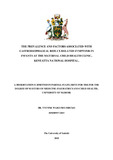| dc.contributor.author | Waigumo, Yvonne | |
| dc.date.accessioned | 2019-01-31T06:02:24Z | |
| dc.date.available | 2019-01-31T06:02:24Z | |
| dc.date.issued | 2018 | |
| dc.identifier.uri | http://hdl.handle.net/11295/106091 | |
| dc.description.abstract | Gastroesophageal reflux (GER) occurs when there is passage into the oesophagus or oropharynx, of stomach contents. It may be accompanied by vomiting. This occurrence is physiological among infants. Regurgitation is a prominent clinical manifestation of gastroesophageal reflux. Rome III diagnostic criteria for infant regurgitation was used in this study. Infant regurgitation has a worldwide prevalence range of 3-87%. Epidemiological studies suggest the prevalence of gastroesophageal reflux varies amongst different ethnic groups. There is currently no information on the prevalence of gastroesophageal reflux among Kenyan infants or the factors associated with these symptoms.
Objectives
The primary objective was to determine the prevalence of gastroesophageal reflux related symptoms among infants aged 1-12 months, attending the maternal child health clinic, Kenyatta National Hospital. The secondary objectives were to identify the factors associated with gastroesophageal reflux related symptoms in these infants, and describe the management of these symptoms in these infants.
Methods
This was a cross-sectional hospital based descriptive study, in infants aged 1 to 12 months, presenting at the maternal child health clinic (Clinic 66), Kenyatta National Hospital. Infants presenting at the clinic were screened and there was sequential enrollment of those who met inclusion criteria. A validated, structured pre-tested questionnaire, the Infant Gastroesophageal Reflux Questionnaire Revised, (IGERQ-R) was administered to assess gastroesophageal reflux symptoms. (IGERQ-R Score of 0 -No reflux, Score>15 –Gastroesophageal reflux disease). Factors associated with these symptoms and management of these symptoms was also assessed. Statistical package for Social Sciences (SPSS) ver. 24, was utilized for data entry and analysis. Categorical data was summarized as frequency distributions and tabulated. Proportions were represented graphically as pie charts and bar graphs. Bivariate and multivariate analysis was undertaken to establish variables statistically associated with symptom severity of gastroesophageal reflux.
Results
Four hundred and fourteen (414) infants were enrolled into the study, 269(65%) infants were aged 1-6 months and 145 (35%) 7 -12 months of age, with a male-to-female ratio of 1:1. Prevalence of regurgitation according to Rome III diagnostic criteria amongst our study
xi
population was 72.9%. Infants aged 1-6 months had a prevalence of 84%, while those 7-12 months of age had a prevalence of 52.4%.
The association between infant age as a demographic variable and gastroesophageal reflux related symptoms was significant (p= 0.003). Complementary feeding was associated with decreased gastroesophageal symptoms, however this was not found to be significant. There was no significant association found with regards to gastroesophageal reflux symptoms and gender of the infant, care giver age and level of education or number of children within the household. There was no infant found to have a score of 16 or greater which is a positive score, for gastroesophageal reflux disease.
Only 25 (6.03%) infants were reported to have received treatment for GER symptoms. Of these 72% received non-pharmacological treatment compared to pharmacological treatment (28%), 90% reported improvement of symptoms.
Conclusion
The prevalence of regurgitation in infants aged 1-12 months according to Rome III diagnostic criteria was 72.9%. Infant age was significantly related to gastroesophageal reflux symptoms. Frequency and severity of these symptoms decreased with age as evaluated by IGERQ-R. No infant was found to have gastroesophageal reflux disease (IGERQ-R Score >15). There was improvement of gastroesophageal reflux symptoms with non-pharmacological treatment.
Recommendations
We recommend education of caregivers on resolution of gastroesophageal reflux symptoms with increase in age and efficacy of non-pharmacological treatment as condition is physiological. Encourage utilization of the Infant gastroesophageal reflux questionnaire revised (I-GERQ-R) to screen infants who present with gastroesophageal reflux symptoms, and assess severity of these symptoms | en_US |
| dc.language.iso | en | en_US |
| dc.publisher | University of Nairobi | en_US |
| dc.rights | Attribution-NonCommercial-NoDerivs 3.0 United States | * |
| dc.rights.uri | http://creativecommons.org/licenses/by-nc-nd/3.0/us/ | * |
| dc.subject | The Prevalence and Factors Associated With Gastroesophageal Reflux Related Symptoms in Infants at the Maternal Child Health Clinic, Kenyatta National Hospital. | en_US |
| dc.title | The Prevalence and Factors Associated With Gastroesophageal Reflux Related Symptoms in Infants at the Maternal Child Health Clinic, Kenyatta National Hospital. | en_US |
| dc.type | Thesis | en_US |
| dc.description.department | a
Department of Psychiatry, University of Nairobi, ; bDepartment of Mental Health, School of Medicine,
Moi University, Eldoret, Kenya | |



